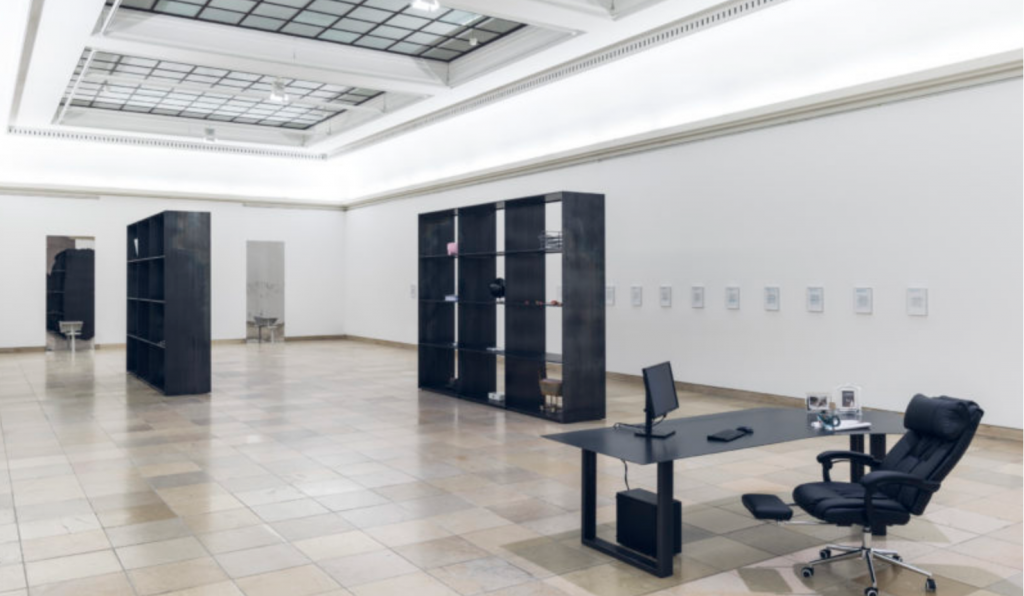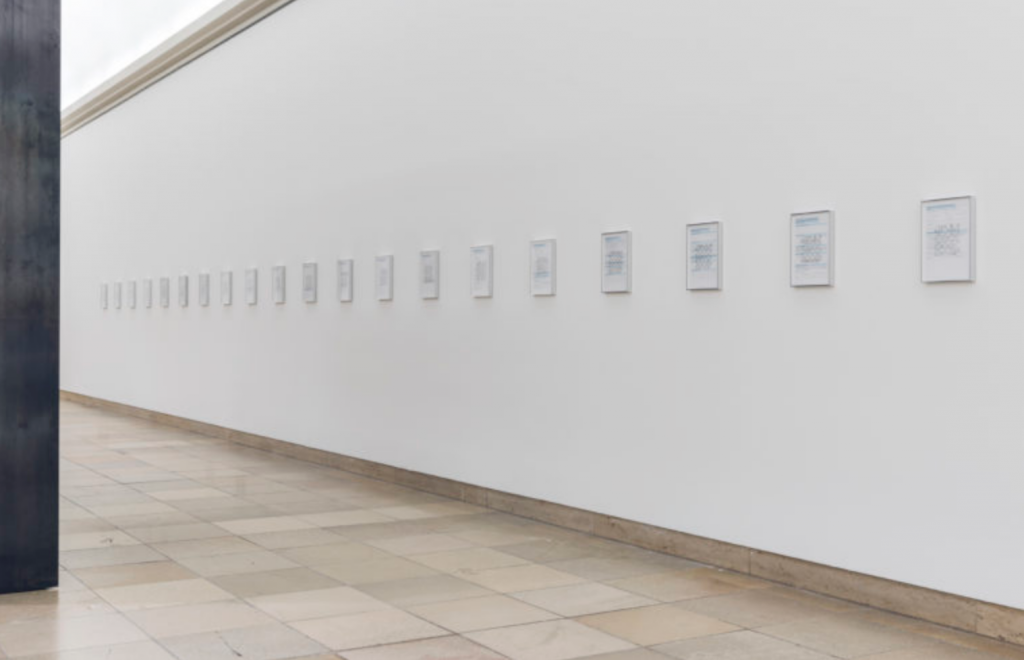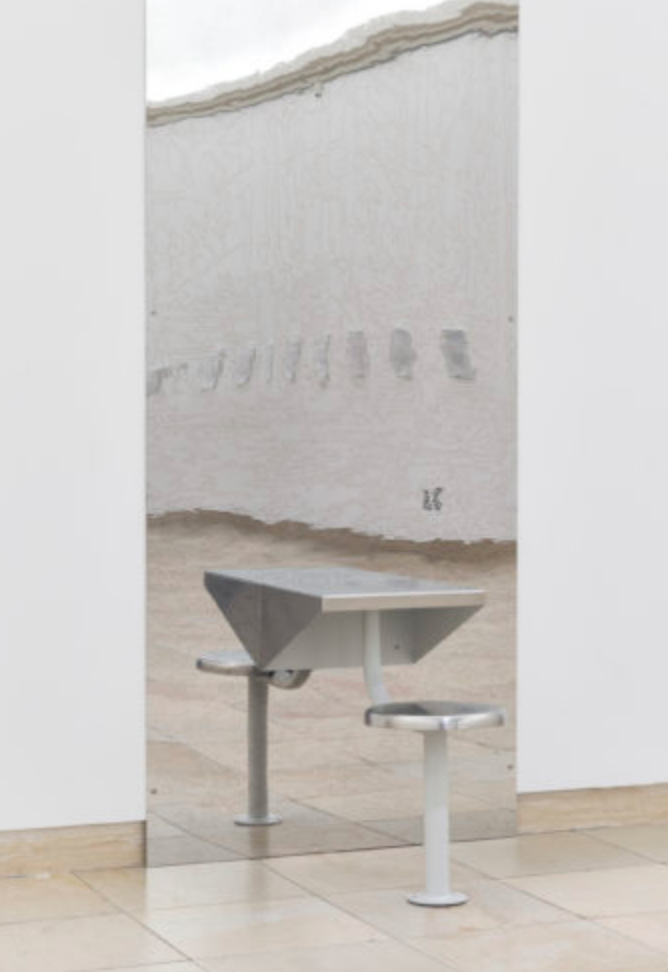How Artist Sung Tieu’s Prescient Installation of a Bureaucratic Office at Haus der Kunst Took on New Meaning After Lockdown


Artnet Gallery Network

Every year, Haus der Kunst, Munich’s leading contemporary art museum, commissions a site-specific installation to fill its South Gallery spaces as part of its annual Capsule project. For its eleventh edition, the museum has chosen Vietnamese-German artist Sung Tieu, who created a multimedia installation investigating the psychological effects—and ambiance—of a bureaucratic administrative office.
The work, which came on view in late January before lockdown, was named Zugzwang—a term, that in games like chess, signifies the quandary of when a player is put at a disadvantage by having to make a move. That absurdist spirit defines the installation, an imaginary immigration office of a fictitious bureaucrat named Mr. James Stevens.
Throughout the space are the effects of an office—a desk, newspapers, some small knick-knacks. Music by Richard Wagner plays out from an undefined source, but it’s muddled and obscured by the sounds of phones ringing, keyboards, and mouse-clicking.
Here, fact and fiction blur together until they are nearly indistinguishable. Real bureaucratic forms—for asylum, residency, and naturalization—are framed along a wall, but Tieu has edited and modified the documents so that it’s impossible to determine exactly where they are from, but which nevertheless convey the randomness of immigration and its invasiveness on individuals.
We spoke with Damian Lentini, the curator of the show, to talk about the re-opened exhibition and how the significance of “Zugzwang” has changed during this unprecedented year.

Installation view of “Zugwang,” 2020. Courtesy of the artist and Haus der Kunst.
This exhibition was planned in January 2019. Obviously, much has changed since then. How has the meaning of the exhibition shifted or developed given the recent shutdown?
I believe that the meaning of the exhibition became significantly darker–and at the same time, felt closer to home, especially with regard to the manner in which it outlined how the bureaucratic apparatus reduced all human subjects to mere data or numbers, which are then moved through the system as one would move pieces within a game of chess (hence the title). Given that we were subjected to almost daily reports concerning the statistics of the pandemic and the measure to bring it under control (weighing up the need to protect the most vulnerable against the economic consequences of shutting down businesses; or the tragic stories emanating out of Spain or Italy of doctors who have to decide who lived or died based upon their perceived chance of “success”), suddenly this notion of being reduced to a “pawn” moved very promptly away from something which occurred to “other people” and suddenly felt ominously present within all of our everyday lives.
Sound figures prominently within the project to create a unique psychological effect. How do you see sound operating in this installation?
We said from the very outset that the work was primarily a sound sculpture. As opposed to sound animating the objects, the objects acted as extensions of the sound, which defined and sculpted one’s passage through the space. For this reason, it was important to conceal the sources of the sounds, as this would concurrently conceal the fact that visitors’ movements were being dictated by the various sound channels—if one could see the speakers, for example, one would be aware of moving toward or away from the sound source. By concealing the sources of the sounds, however, visitors were left unaware of their proximity to a certain speaker, meaning that their movement through the space was dictated primarily by sonic means.

Installation view of “Zugwang,” 2020. Courtesy of the artist and Haus der Kunst.
Within the exhibition, elements of prison design and furniture are quietly entwined. How do you think Sung Tieu explores design as a form of control or oppression?
For many visitors, the “prison furniture” bore more of a resemblance to the sorts of seating you’d find in urban spaces (such as park benches or waiting rooms). It was only when one noticed, for example, that these seating units were attached to the floor with very heavy screws, or that the combination of the seat with the mirrored surface elicited an uncanny sense of being observed, that one began to sense a penal element to the work… but on the whole, this was countered by the soundtrack, which very much anchored the work within a bureaucratic environment. It was only upon leaving the exhibition and reading the wall text (or the catalogue essay), that the penny dropped. I should note that this is not a strategy that Tieu first employed with this work; the almost complete concealment of penal aesthetics within everyday spaces is prevalent throughout her most recent works.
The installation erases the lines between fact and fiction, in a way that is disorienting. Mr. James Stevens is a fictitious bureaucrat who is based on a real person, for instance. Can you speak to that?
The blurring of fact and fiction to the point where it is impossible to perceive a defined border between them essentially also eliminates the other binaries evident throughout the exhibition: not just that of applicant/interviewer but, more importantly, between self/other. As is emphasized by the chess game taking place over the top of the documents lined up along the wall, the exchange between these two positions necessarily involves an intermingling of truth and fiction in order for the “game” to be played: the applicant needs to alter the “truth” of their responses so as to accord with the questions being asked, while the interviewer/bureaucrat has to in turn alter these responses so that they accord with their interpretation of them (and logic of their subsequent input into the bureaucratic system). Similarly, the newspaper articles positioned throughout the exhibition demonstrate that this “game” of truth/fiction is not simply confined to certain specific situations, such as applying for refugee status, but is in fact prevalent throughout the entire bureaucratic superstructure—irrespective of one’s status.
In your own words, why is this an important show to see? Why should someone come see it?
“Zugzwang” is Sung Tieu’s first major institutional exhibition (alongside In Cold Print at Nottingham Contemporary, which opened a week later) and represents the first opportunity to see her work on such a scale. Furthermore, the exhibition in Munich feels like the culmination of a research project that she has been undertaking for several years, and which has been previously presented in smaller exhibitions in London and Berlin. But the exhibitions in Munich and Nottingham (and the subsequent publication of the co-produced catalogue Sung Tieu. Oath Against Minimalism) provides the public with the opportunity to see her really develop her ideas and thinking—particularly in regard to the sculptural potential of sound—in more depth and nuance than ever before.
“Zugzwang” is on view at Haus der Kunst through August 31, 2020.